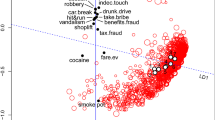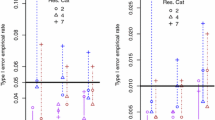Abstract
The paper aims to improve the Thurstone scaling method by reducing the workload of data collection and simplifying the procedures of application. It proposes a hierarchical structure for organizing items that are to be scaled. Instead of making paired comparisons, the respondents would be asked to rank the items. The ranks of the items would then be transformed into paired comparisons. Workload of data collection can hence be greatly reduced. As an alternative to Thurstone model, the use of three models, i.e., linear, exponential and information, to compute serious scores is also demonstrated.
Similar content being viewed by others
References
Bartholomew D.J. (1993). The statistical approach to social measurement. in Krebs D., Schmidt P. (eds.) New Directions in Attitude Measurement. Walter de Gruyter, New York
Bergner M., Bobbitt R., Carter W., Gilson B. (1992). Measuring Health: A Review of Quality of Life Measurement Scales. Open University Press, Buckingham
Bowling A. (1997). Measuring Health: A Review of Quality of Life Measurement Scales. Open University Press, Buckingham
Hunt S.M., McEwen J., Mckenna S.P. (1986). Measuring Health Status. Croom Helm, London
Ip W.C., Kwan Y.K., Pong G.T.Y., Trout M.D. (1999). Development and demonstration of a hierarchical health status instrument for the elderly. Journal of Social Service Research 25(4): 43–56
Ip, W.C., Y.K. Kwan and L.L. Chiu: 2004, Construction of health indices using paired comparisons. Social Indicators Research. To appear
Kwan Y.K., Ip W.C., Kwan P. (2000). A crime index with Thurstone’s scaling of crime severity. Journal of Criminal Justice 28: 237–244
Kwan Y.K., Chiu L.L., Ip W.C., Kwan P.Y.K. (2002): Perceived crime seriousness: Consensus and disparity. Journal of Criminal Justice 30: 623–632
Lazarsfeld P.F. (1950). The logical and mathematical foundation of latent structure analysis. In: Stouffer S.A. (ed.) Measurement and Prediction. Princeton University Press, Princton, NJ
Medical Outcomes Trust (1993). How to Score the SF-36 Health Survey. Collins, Boston
Thurstone L.L. (1927). A law of comparative judgement. Psychometric Review 34: 273–286
Thurstone L.L. (1928). Attitudes can be measured. American Journal of Sociology 33: 529–554
Thurstone L.L., Chave E.J. (1929). The Measurement of Attitude. University of Chicago Press, Chicago
Ware J.E., Sherbourne C.D. (1992). The MOS 36-item short form health survey (SF-36): Conceptual framework and item selection. Medical Care 30: 473–483
Acknowledgement
This research was supported by a research grant from The Hong Polytechnic University Research Committee.
Author information
Authors and Affiliations
Corresponding author
Rights and permissions
About this article
Cite this article
Ip, W.C., Kwan, Y.K. & Chiu, L.L. Modification and simplification of thurstone scaling method, and its demonstration with a crime seriousness assessment. Soc Indic Res 82, 433–442 (2007). https://doi.org/10.1007/s11205-006-9040-z
Accepted:
Published:
Issue Date:
DOI: https://doi.org/10.1007/s11205-006-9040-z




